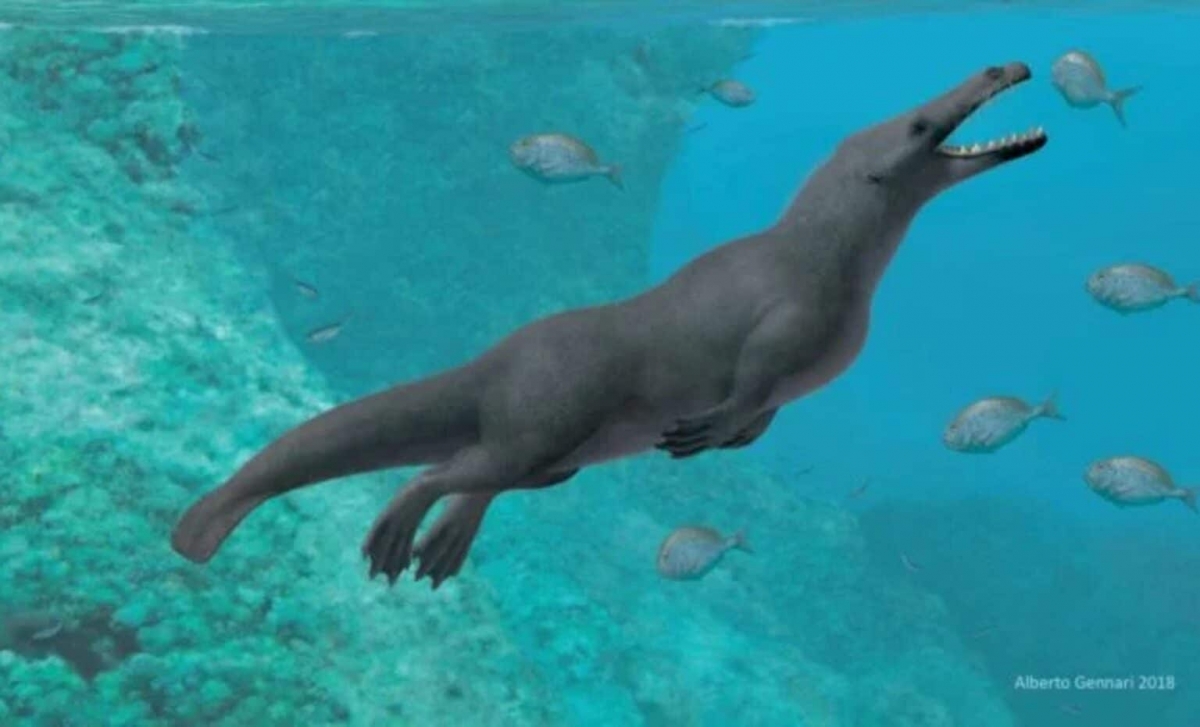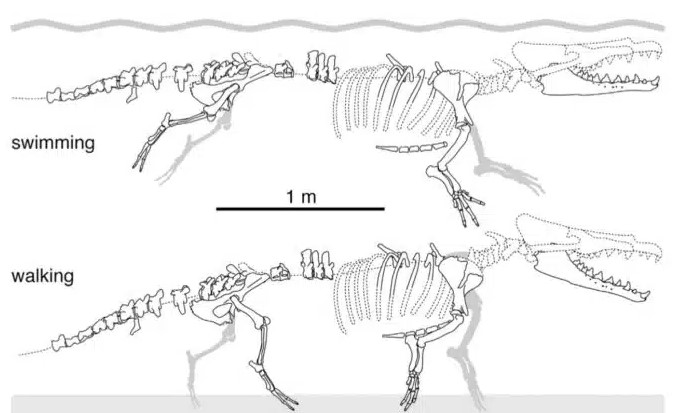Ancient Four-Legged Whale Remains Discovered in Peru Could Rewrite Whale Evolution!

Paleontologists have discovered the remains of a previously unidentified four-legged whale species off the coast of Peru, which is an exciting new discovery.
The evolutionary transformation of whales from land-dwelling mammals to the aquatic giants we know today is being illuminated by this amazing discovery, which was made approximately 42.6 million years ago during the middle Eocene.
As described in Current Biology, the whale species, called Peregocetus pacificus, was found in the Playa Media Luna fossil site and constitutes a vital piece of the puzzle understanding whale migration patterns and early evolutionary development.
The finding represents a significant turning point in our knowledge of the evolution and global dispersal of cetaceans.
The evolutionary transformation of whales from land-dwelling mammals to the aquatic giants we know today is being illuminated by this amazing discovery, which was made approximately 42.6 million years ago during the middle Eocene.
As described in Current Biology, the whale species, called Peregocetus pacificus, was found in the Playa Media Luna fossil site and constitutes a vital piece of the puzzle understanding whale migration patterns and early evolutionary development.
The finding represents a significant turning point in our knowledge of the evolution and global dispersal of cetaceans.
Did you know? You can comment on this post! Just scroll down
An Unexpected Connection in the Evolutionary Chain: The Whale with Four Legs
An ancient quadrupedal whale, or one with four legs and the ability to walk on land, was the Peregocetus pacificus.
The fact that this discovery offers the first trustworthy account of a quadrupedal whale in South America makes it very noteworthy.
Paleontologists have recovered a significant amount of the fossil's skeleton, including its jaw, front and rear limbs, portions of its spine, and tail, demonstrating how well-preserved it is.
Another notable aspect of Peregocetus pacificus is its size. Although it was much larger than contemporary otters at about 4 meters (13 feet) in length, it still shared many traits with beavers and otters that were adapted for land movement.
An ancient quadrupedal whale, or one with four legs and the ability to walk on land, was the Peregocetus pacificus.
The fact that this discovery offers the first trustworthy account of a quadrupedal whale in South America makes it very noteworthy.
Paleontologists have recovered a significant amount of the fossil's skeleton, including its jaw, front and rear limbs, portions of its spine, and tail, demonstrating how well-preserved it is.
Another notable aspect of Peregocetus pacificus is its size. Although it was much larger than contemporary otters at about 4 meters (13 feet) in length, it still shared many traits with beavers and otters that were adapted for land movement.
This shows that the whale’s evolutionary forebears were capable of both walking on land and swimming in water, bridging the gap between terrestrial mammals and modern whales.

The Role of the South Pacific in Whale Evolution
The discovery of Peregocetus pacificus raises fascinating questions about the evolutionary history of whales and their adaptation to life in the ocean.
According to Olivier Lambert, lead author of the study and a paleontologist at the Royal Belgian Institute of Natural Sciences, this is the first indisputable record of a quadrupedal whale skeleton in the Pacific Ocean, and it may be the oldest of its kind in the Americas.
The fossil evidence implies that these early whales likely crossed the South Atlantic Ocean from the western coast of Africa, supported by surface currents that helped them navigate the journey.
The discovery of Peregocetus pacificus raises fascinating questions about the evolutionary history of whales and their adaptation to life in the ocean.
According to Olivier Lambert, lead author of the study and a paleontologist at the Royal Belgian Institute of Natural Sciences, this is the first indisputable record of a quadrupedal whale skeleton in the Pacific Ocean, and it may be the oldest of its kind in the Americas.
The fossil evidence implies that these early whales likely crossed the South Atlantic Ocean from the western coast of Africa, supported by surface currents that helped them navigate the journey.
The trek was easier to handle back then because South America and Africa were considerably closer than they are now.
The evolution of whales was changed when the Peregocetus whales arrived in South America, established along the Peruvian coast, and then moved into North America.
According to Erich Fitzgerald, senior curator of vertebrate paleontology at Museums Victoria in Melbourne, "this is a truly surprising discovery based on a relatively complete fossil skeleton that shows that really ancient whales capable of swimming and walking made it to the Americas much earlier than previously thought."
From Earth to Ocean: Whale Evolution
The evolution of whales was changed when the Peregocetus whales arrived in South America, established along the Peruvian coast, and then moved into North America.
According to Erich Fitzgerald, senior curator of vertebrate paleontology at Museums Victoria in Melbourne, "this is a truly surprising discovery based on a relatively complete fossil skeleton that shows that really ancient whales capable of swimming and walking made it to the Americas much earlier than previously thought."
From Earth to Ocean: Whale Evolution
An important piece in the evolution of cetaceans has been added with the finding of Peregocetus pacificus. About 50 million years ago, land-dwelling mammals are thought to have given way to whales, dolphins, and other cetaceans.
Researchers can gain a better understanding of the timeframe of this significant evolutionary shift and how whales made the transfer from land to sea by studying Peregocetus.
Scientists are keen to continue studying the fossil-rich regions of Peru, since this discovery demonstrates the potential for future finds in the southern hemisphere.
Paleontologist Felix Marx of the University of Liège thinks the finding may provide additional information about how ancient whales dispersed throughout the oceans.
Researchers can gain a better understanding of the timeframe of this significant evolutionary shift and how whales made the transfer from land to sea by studying Peregocetus.
Scientists are keen to continue studying the fossil-rich regions of Peru, since this discovery demonstrates the potential for future finds in the southern hemisphere.
Paleontologist Felix Marx of the University of Liège thinks the finding may provide additional information about how ancient whales dispersed throughout the oceans.
Erich Fitzgerald remarked, "There are undoubtedly more facets to the whale's story that we haven't even started to consider, but one thing is for sure: there are a lot more cetacean surprises in the southern hemisphere that are just waiting to be discovered."
Article Posted 1 Month ago. You can post your own articles and it will be published for free.
No Registration is required! But we review before publishing! Click here to get started

















